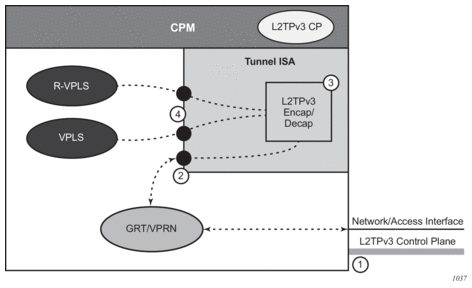5. L2TPV3 Tunnels
5.1. L2TPv3 Overview
Layer 2 Tunneling Protocol version 3 (L2TPv3) is a mechanism for the tunneling of Ethernet traffic over an IP network. For this application, the MS-ISA/MS-ISA2 functions as a resource module for the system, performing the L2TPv3 encapsulation and decapsulation functions.
Figure 44 shows L2TPv3 support for the IP transport model. Table 30 describes the tunnel processing steps in the figure.
Figure 44: L2TPv3 Support for IP Transport

Table 30: L2TPv3 Support for IP Transport — Tunnel Processing Steps
Step Number | Description |
1 | The L2TPv3 control plane can run within either the base routing or VPRN contexts. |
2 | L2TPv3 encapsulated packets ingress and egress through the public interface, which can be in either the base routing or VPRN contexts. |
3 | L2TPv3 encapsulation and decapsulation processing is handled within the tunnel ISA. |
4 | Unencapsulated packets pass between the tunnel ISA and the associated service via the configured private SAP. |
5.2. Control Plane
The configuration of the L2TPv3 control plane is similar to that of L2TPv2. A number of the same commands are used for both, but there are new commands specific to L2TPv3. The L2TPv3-specific commands are located in a separate L2TPv3 context in both the general configuration area as well as within the group configuration context.
L2TPv3 control plane parameters can be configured at either the global level within the config>router>l2tp context, which may include some L2TPv3-specific parameters. This should be used for parameters that are the same for the majority of L2TPv3 tunnels. The same parameters can be configured on a per-tunnel group basis. The tunnel group can be configured within either the base router context or a VPRN service context. The following is a simple example for an L2TPv3 tunnel group configured within the base routing context.
5.3. Public SAP
The public SAP is the access interface to the L2TPv3 tunnel over which encapsulated traffic is sent to or received from the far end. The IP address bound to this SAP is on the same subnet as the local L2TPv3 tunnel endpoint.
The public SAP must be configured in the same routing context as the L2TPv3 tunnel group configuration. As shown in Figure 44, the public SAP can be associated with an IES or VPRN service to connect to the outside or public access network.
Below is a simple example for an L2TPv3 public SAP configured within the base routing context.
5.4. Private SAP
The private SAP is the access interface to the L2TPv3 over which unencapsulated traffic is sent to or received from the far end. The public SAP must be configured within an Ethernet service, such as an Epipe, VPLS, or I-VPLS service.
The private SAP configuration includes the configuration of the following L2TPv3 session parameters:
- VC-ID
- PW-Type
- L2TPv3 tunnel group association
Below is a simple example for an L2TPv3 private SAP configured within the base routing context.